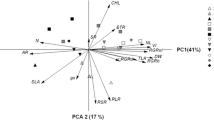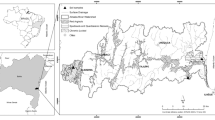Abstract
Willows are used as cuttings or in fascines for riverbank soil bioengineering, to control erosion with their high resprouting ability and rapid growth. However, water availability is highly variable along riverbanks both in time and space and constitutes a major stress limiting willow establishment. A species-specific understanding of willow cutting response to water stress is critical to design successful riverbank soil bioengineering projects given exclusive use of local species is often recommended. In a three-month greenhouse experiment, we investigated the effects of three soil moisture treatments (drought—soil saturation—intermittent flooding) on survival, biomass production and root growth of cuttings of three willow species used for soil bioengineering along NE American streams (Salix discolor—S. eriocephala—S. interior). Cutting survival was high for all species and treatments (>89%). Biomass production and root volume only differed between species. S. eriocephala produced the highest biomass and root volume, and S. discolor invested more in belowground than aboveground biomass. Root length responded to soil moisture differently between species. Under intermittent flooding, S. eriocephala produced shorter roots, while S. interior produced longer roots. For riverbank soil bioengineering, S. eriocephala should be favored at medium elevation and S. interior at lower elevation.



Similar content being viewed by others
References
Amlin NA, Rood SB (2001) Inundation tolerances of riparian willows and cottonwoods. JAWRA 37:1709–1720. https://doi.org/10.1111/j.1752-1688.2001.tb03671.x
Bourgeois B, González E (2019) Pulses of seed release in riparian Salicaceae coincide with high atmospheric temperature. River Res Appl 35:1590–1596. https://doi.org/10.1002/rra.3505
Caplan TR, Cothern K, Landers C, Hummel OC (2013) Growth response of coyote willow (Salix exigua) cuttings in relation to alluvial soil texture and water availability. Restor Ecol 21:627–638. https://doi.org/10.1111/j.1526-100X.2012.00928.x
Catford JA, Jansson R (2014) Drowned, buried and carried away: effects of plant traits on the distribution of native and alien species in riparian ecosystems. N Phytol 204:19–36. https://doi.org/10.1111/nph.12951
Douhovnikoff V, McBride JR, Dodd RS (2005) Salix exigua clonal growth and population dynamics in relation to disturbance regime variation. Ecology 86:446–452. https://doi.org/10.1890/04-0257
Doffo GN, Monteoliva SE, Rodríguez ME, Luquez VMC (2017) Physiological responses to alternative flooding and drought stress episodes in two willow (Salix spp.) clones. Can J For Res 47:174–182. https://doi.org/10.1139/cjfr-2016-0202
Evette A, Labonne S, Rey F, Liebault F, Jancke O, Girel J (2009) History of bioengineering techniques for erosion control in rivers in western Europe. Environ Manag 43:972–984. https://doi.org/10.1007/s00267-009-9275-y
Francis RA, Gurnell AM, Petts GE, Edwards PJ (2005) Survival and growth responses of Populus nigra, Salix elaeagnos and Alnus incana cuttings to varying levels of hydric stress. For Ecol Manag 210:291–301. https://doi.org/10.1016/j.foreco.2005.02.045
Fang W, Pan SW, He P, Liu Y, Ma LH, Li J, Sun Y (2015) Effects of pioneer plants richness on community characteristics of vegetation and their soil and water conservation benefit for highway side slope. Acta Ecol Sin 35:3653–3662. https://doi.org/10.5846/stxb201308102055
Garssen AG, Verhoeven JTA, Soons MB (2014) Effects of climate-induced increases in summer drought on riparian plant species: a meta-analysis. Freshw Biol 59:1052–1063. https://doi.org/10.1111/fwb.12328
González E, Bourgeois B, Masip A, Sher AA (2016) Trade-offs in seed dispersal strategies across riparian trees: the how matters as much as the when. River Res Appl 32:786–794. https://doi.org/10.1002/rra.2899
Gray D, Soti R (1996) Biotechnical and soil bioengineering slope stabilization—a practical guide for erosion control. John Wiley & Sons, New York, NY
Jackson MB, Attwood PA (1996) Roots of willow (Salix viminalis L.) show marked tolerance to oxygen shortage in flooded soils and in solution culture. Plant Soil 187:37–45. https://doi.org/10.1007/BF00011655
Jia H, Wang L, Li J, Sun P, Lu M, Hu J (2020) Physiological and metabolic responses of Salix sinopurpurea and Salix suchowensis to drought stress. Trees 34:563–577. https://doi.org/10.1007/s00468-019-01937-z
Karrenberg S, Edwards PJ, Kollmann J (2002) The life history of Salicaceae living in the active zone of floodplains. Freshw Biol 47:733–748. https://doi.org/10.1046/j.1365-2427.2002.00894.x
Kollmann J, Vieli M, Edwards PJ, Tockner K, Ward JV (1999) Interactions between vegetation development and island formation in the Alpine river Tagliamento. Appl Veg Sci 2:25–36. https://doi.org/10.2307/1478878
Kozlowski TT (1997) Responses of woody plants to flooding and salinity. Tree Physiol 17:490–519. https://doi.org/10.1093/treephys/17.7.490
Krasny ME, Zasada JC, Vogt KA (1998) Adventitious rooting of four Salicaceae species in response to a flooding event. Can J Bot 66:2597–2598. https://doi.org/10.1139/b88-352
Kui L, Stella JC (2016) Fluvial sediment burial increases mortality of riparian tree seedling but induces compensatory growth response in survivors. For Ecol Manag 366:32–40. https://doi.org/10.1016/j.foreco.2016.02.001
Kuzovkina YA, Volk TA (2009) The characterization of willow (Salix L.) varieties for use in ecological engineering applications: co-ordination of structure, function and autecology. Ecol Eng 35:1178–1189. https://doi.org/10.1016/j.ecoleng.2009.03.010
Lavaine C, Evette A, Piégay H (2015) European Tamaricaceae in bioengineering on dry soils. Environ Manag 56:221–232. https://doi.org/10.1007/s00267-015-0499-8
Li S, Pezeshki SR, Goodwin S, Shields Jr FD (2004) Physiological responses of black willow (Salix nigra) cuttings to a range of soil moisture regimes. Photosynthetica 42:585–590. https://doi.org/10.1007/S11099-005-0017-y
Li S, Pezeshki SR, Shields DF (2006) Partial flooding enhances aeration in adventitious roots of black willow (Salix nigra) cuttings. J Plant Physiol 163:619–628. https://doi.org/10.1016/j.jplph.2005.06.010
Malanson GP (1993) Riparian landscapes. Cambridge University Press, Cambridge
Marie-Victorin FEC, Brouillet L, Rouleau E, Goulet I, Hay S (2002) Flore Laurentienne, 4th edition. Gaëtan Morin, Montréal
Markus-Michalczyk H, Hanelt D, Denstorf J, Jensen K (2016) White willow sexual regeneration capacity under estuarine conditions in times of climate change. Estuar Coast Mar Sci 180:51–58. https://doi.org/10.1016/j.ecss.2016.06.025
Mosseler A, Major JE, Labrecque M (2014) Growth and survival of seven native willow species on highly disturbed coal mine sites in eastern Canada. Can J For Res 44:340–349. https://doi.org/10.1139/cjfr-2013-0447
Naiman R, Décamps H, McClain M (2005) Riparia: ecology, conservation, and management of streamside communities. Academic Press, Cambridge
Nakai A, Kisanuki H (2011) Stress responses of Salix gracilistyla and Salix subfragilis cuttings to repeated flooding and drought. J For Res 16:465–472. https://doi.org/10.1007/s10310-010-0238-1
Parent C, Capelli N, Berger A, Crèvecoeur M, Dat JF (2008) An overview of plant responses to soil waterlogging. Plant Stress 2:20–27
Pezeshki SR, Anderson PH, Shields FD (1998) Effects of soil moisture regimes on growth and survival of black willow (Salix nigra) posts (cuttings). Wetlands 18:460–470. https://doi.org/10.1007/BF03161538
Pezeshki SR, Li S, Shields FD, Martin LT (2007) Factors governing survival of black willow (Salix nigra) cuttings in a streambank restoration project. Ecol Eng 29:56–65. https://doi.org/10.1016/j.ecoleng.2006.07.014
Rechinger KH (1992) Salix taxonomy in Europe—problems, interpretations, observations. P R Soc Edinb B 98:1–12. https://doi.org/10.1017/S0269727000007417
Savage JA, Cavender-Bares JM (2011) Contrasting drought survival strategies of sympatric willows (genus: Salix): consequences for coexistence and habitat specialization. Tree Physiol 31:604–614. https://doi.org/10.1093/treephys/tpr056
Shields Jr FD, Pezeshki SR, Anderson PH (1998) Probable causes for willow post mortality. In: Engineering approaches to ecosystem restoration. Proceedings of the 1998 Wetlands Engineering and River Restoration Conference, Denver, CO, 22–27 March 1998. Edited by the American Society of Civil Engineers, New York, NY, p 157–162
Veihmeyer FJ, Hendrickson AH (1931) The moisture equivalent as a measure of the field capacity of soils. Soil Sci 31:181–194. https://doi.org/10.1097/00010694-193109000-00003
Wikberg J, Ögren E (2004) Interrelationships between water use and growth traits in biomass-producing willows. Trees-Struct Funct 18:70–76. https://doi.org/10.1007/s00468-003-0282-y
Wikberg J, Ögren E (2007) Variation in drought resistance, drought acclimation and water conservation in four willow cultivars used for biomass production. Tree Physiol 27:1339–1346. https://doi.org/10.1093/treephys/27.9.1339
Zalesny Jr RS, Wiese AH (2006) Date of shoot collection, genotype, and original shoot position affect early rooting of dormant hardwood cuttings of Populus. Sylvae Genet 55:169–182
Acknowledgements
This study was supported by the FASAM project (Formation pour la sécurité alimentaire au Mali), the Natural Sciences and Engineering Research Council of Canada (Discovery grant RGPIN-2014-05663 to MP), the Quebec Ministry of Transport, and the Quebec Ministry of International Relations through the 66th session of the program Cooperation France-Québec. The authors thank Isabelle Clermont, Steeve Pépin, and field assistants for their help during experiment set-up and monitoring as well as Hélène Crépeau for statistical advice.
Author information
Authors and Affiliations
Corresponding author
Ethics declarations
Conflict of Interest
The authors declare no competing interests.
Additional information
Publisher’s note Springer Nature remains neutral with regard to jurisdictional claims in published maps and institutional affiliations.
Supplementary information
Rights and permissions
About this article
Cite this article
Keita, N., Bourgeois, B., Evette, A. et al. Growth Response of Cuttings to Drought and Intermittent Flooding for Three Salix Species and Implications for Riverbank Soil Bioengineering. Environmental Management 67, 1137–1144 (2021). https://doi.org/10.1007/s00267-021-01444-3
Received:
Accepted:
Published:
Issue Date:
DOI: https://doi.org/10.1007/s00267-021-01444-3




